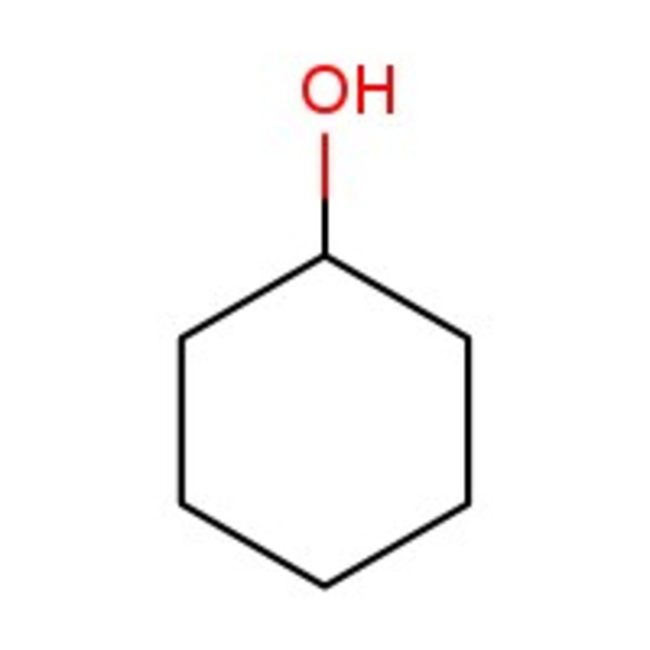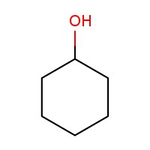Search Thermo Fisher Scientific
Thermo Scientific Chemicals
Cyclohexanol, 99%
CAS: 108-93-0 | C6H12O | 100.161 g/mol
| Catalog Number | Quantity |
|---|---|
| ALFA17576.AE | 100 mL |
Catalog number ALFA17576.AE
View Price:Sign InSign in to see your account pricing. Need an account? Register with us today.
Quantity:
100 mL
Specifications
Chemical Name or MaterialCyclohexanol
CAS108-93-0
Health Hazard 1H227-H302+H332-H315-H319-H335
Health Hazard 2GHS H Statement
H302-H332-H315-H335-H227
H302-H332-H315-H335-H227
Health Hazard 3P210-P235-P261-P264b-P270-P271-P280-P301+P312-P302+P352-P304+P340-P305+P351+P338-P312-P330-P332+P313-P362-P370+P378q-P501c
View more
Cyclohexanol is used in making soaps, dry cleaning agents and plasticizers. It acts as a solvent for rubber, resins, nitrocellulose, metallic soaps, oils, esters and ethers. It is used in the preparation of adipic acid, hexamethylene diamine, cyclohexanone and caprolactam. It acts as a soap stabilizing agent, disinfection medicated soap and detergent emulsion. It is also useful for paint blending agent, leather degreasing agent and polishes.
This Thermo Scientific Chemicals brand product was originally part of the Alfa Aesar product portfolio. Some documentation and label information may refer to the legacy brand. The original Alfa Aesar product / item code or SKU reference has not changed as a part of the brand transition to Thermo Scientific Chemicals.
Applications
Cyclohexanol is used in making soaps, dry cleaning agents and plasticizers. It acts as a solvent for rubber, resins, nitrocellulose, metallic soaps, oils, esters and ethers. It is used in the preparation of adipic acid, hexamethylene diamine, cyclohexanone and caprolactam. It acts as a soap stabilizing agent, disinfection medicated soap and detergent emulsion. It is also useful for paint blending agent, leather degreasing agent and polishes.
Solubility
Miscible with ethanol, ethyl ether acetone, chloroform, ethyl acetate, linseed oil and benzene. Slightly miscible with cold water.
Notes
Hygroscopic. Incompatible with strong oxidizing agents, hydrogen peroxide and nitric acid.
Cyclohexanol is used in making soaps, dry cleaning agents and plasticizers. It acts as a solvent for rubber, resins, nitrocellulose, metallic soaps, oils, esters and ethers. It is used in the preparation of adipic acid, hexamethylene diamine, cyclohexanone and caprolactam. It acts as a soap stabilizing agent, disinfection medicated soap and detergent emulsion. It is also useful for paint blending agent, leather degreasing agent and polishes.
Solubility
Miscible with ethanol, ethyl ether acetone, chloroform, ethyl acetate, linseed oil and benzene. Slightly miscible with cold water.
Notes
Hygroscopic. Incompatible with strong oxidizing agents, hydrogen peroxide and nitric acid.
RUO – Research Use Only
General References:
- Cyclohexyl esters can be used to protect carboxylic acids, including aspartate residues in peptide synthesis, resulting in reduced aspartimide formation during acidic or basic reactions: Synthesis, 361 (1992). They are relatively stable to TFA but can be readily cleaved by TfOH or HF: Int. J. Pept. Protein Res., 13, 418 (1979); Tetrahedron Lett., 4033 (1979); Chem. Pharm. Bull., 34, 864 (1986). See also 2,4-Dimethyl-3-pentanol, B20821 .
- Schemeth, D.; Noël, J. C.; Jakschitz, T.; Rainer, M.; Tessadri, R.; Huck, C. W.; Bonn, G. K. Poly(N-vinylimidazole/ethylene glycol dimethacrylate) for the purification and isolation of phenolic acids. Anal. Chim. Acta 2015, 885, 199-206.
- Zhang, P.; Deng, J.; Mao, J.; Li, H.; Wang, Y. Selective aerobic oxidation of alcohols by a mesoporous graphitic carbon nitride-hydroxyphthalimide system under visible-light illumination at room temperature. Chin. J. Catal. 2015, 36 (9), 1580-1586.



